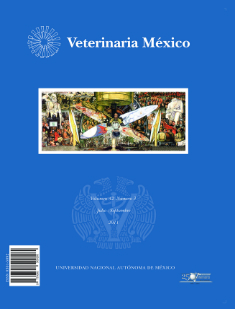Estrous response and conception rate in postpartum Bos taurus-Bos indicus cows, treated with bovine somatotropin in an ovulation induction program with progestogens and eCG
Main Article Content
Abstract
Bovine somatotropin (bST) injection was administered at the beginning of the ovulation induction with progesterone and eCG, and a second one during insemination to prove if it increased estrous response and conception rate (CR) in postpartum beef cows. A hundred and seventy four cows (Bos taurus-Bos indicus) of 60 to 100 days postpartum, with offspring and body condition of 2 to 2.5 were used. A progesterone-releasing intravaginal device (CIDR) was inserted to all females for 9 days and, while removing it, PGF2α was injected. Cows were randomly assigned to the following treatments: eCG (n = 44), received 400 IU of eCG at the moment CIDR was removed; bST (n = 44), received 500 mg of bST when CIDR was inserted and 500 mg of bST during insemination; bST-eCG (n = 44), received 500 mg of bST when CIDR was inserted and 400 IU of eCG while removing it; and 500 mg of bST during insemination; control (n = 42), only received the CIDR. Progesterone concentrations were assessed before the insertion of CIDR. IGF-I serum concentrations were determined in seven cows of each group. At the beginning of the experiment, 93% of the cows were in anoestrus. The rate of cows that showed estrus was similar (P > 0.05) between treatments [eCG (36.4%; bST (45.4%); eCG-bST (52.2%); control (40.4%)]. The CR was not different (P > 0.05) between treatments [eCG (31.2%); bST (15%); eCG-bST (34.7%); control (40%)]. Cows treated with bST had higher IGF-I concentrations than control cows. It is concluded that the injection of bST at the beginning of the ovulation induction with progesterone and eCG, and a second one during insemination does not improve estrous response or fertility in postpartum beef cows.
Keywords:
bST conception rate beef cattle ovulation
Article Details
License

Veterinaria México OA by Facultad de Medicina Veterinaria y Zootecnia - Universidad Nacional Autónoma de México is licensed under a Creative Commons Attribution 4.0 International Licence.
Based on a work at http://www.revistas.unam.mx
- All articles in Veterinaria México OA re published under the Creative Commons Attribution 4.0 Unported (CC-BY 4.0). With this license, authors retain copyright but allow any user to share, copy, distribute, transmit, adapt and make commercial use of the work, without needing to provide additional permission as long as appropriate attribution is made to the original author or source.
- By using this license, all Veterinaria México OAarticles meet or exceed all funder and institutional requirements for being considered Open Access.
- Authors cannot use copyrighted material within their article unless that material has also been made available under a similarly liberal license.



